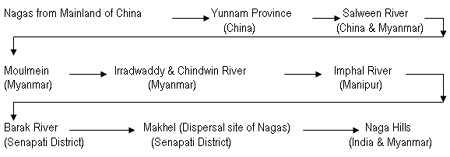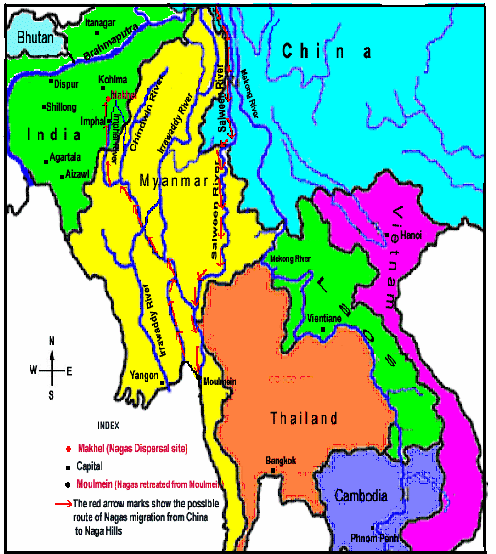| The Route of Nagas Migration |
| By:- R.B. Thohe Pou * |
|
Diagram 1.1 Route of Nagas Migration 
It is believe that the Nagas migrated from Mainland China and follow the southward movement along the route of Salween River and eventually reached the Southern Seas in Moulmein (Myanmar). It is because the Salween River originated from the mainland of China near Tanglha Range and flow to Southern Seas in Moulmein (southern Myanmar) and other tributaries near Bangkok. The Irrawaddy River and Chindwin River do not originate from mainland of China. The Mekong River originated from mainland of China but it runs through Laos, Cambodia and eventually to the Southern Seas in Mytho City in Vietnam. It is not convinced by the historical facts that the Nagas took the route of migration along the Mekong River. The custom and tradition of Nagas are more resemble to the Tribes of Thailand, Myanmar, Indonesia, Philippines and Malaysia than to the tribal people in Laos, Cambodia and Vietnam. Perhaps the Nagas took the route of migration along the Salween River to reach the southern seas of Moulmein (Myanmar). It is supported by historical facts that once the Nagas lived in Irrawaddy valley in the periphery of Salween River. One of the tributaries of Irrawaddy River from Mandalay, (Myanmar) also confluence with Salween River near Loi-Kaw (Myanmar), and it is possible to migrate through this river. Map 1.1 Showing the route of Nagas migration from China to Naga Hills 
The majority of the authorities on Nagas were convinced that once the Nagas lived near the Seas, most probably in Moulmein Sea (Myanmar). It is also supported by their (Nagas) fondness of marine shells in decorating their dresses and the marine shells used by the Nagas for decorating their dresses (Kilt) are not found in the hills. However, they were very familiar with the cowries and conches since time immemorial. The Nagas are basically from the mainland of China. They took southward migration along the Salween River to the south of Moulmein (Myanmar) and lived there for some period of years. It is also believe that some of their (Naga) clans (brothers) left in Moulmein and they retreated to Irrawaddy Valley. The other Naga groups who were left in the vicinity of seas coast continued to press further southward through the south of Myanmar to Malaysia, Indonesia and Philippines. Some of the tribes in Malaysia (Iban, Kayans), Indonesia (Dayaks), Sumatra (Battack) and Philippines (Igorots) are very similar to Naga tribes in their culture and social life. Once the Naga believed to live near the seas but why they migrated to the Hills? It is difficult to ponder on this matter and give a reasonable reason. The reason of their migration from the Southern Seas to the Nagas Hills is still obscured. Some of the probable reasons for their retreating may be mentioned as- i) The plain people who were more civilized with better equipment in warfare in Moulmein or near the seas coast might have pressed the Nagas to push up to Irrawaddy Valley. ii) There may be frequents waves, tornadoes and pestilence living near the seacoast. iii) Another reason may be, they were safer from their enemies' attacks living in the hills than living in the plain, where there is no much protection. iv) As they are basically from the mainland, they may not be acclimatized near the seacoast and wanting to have other occupations like hunting, gathering fruits, cultivation etc they might shift to the hills. There was not historical record like - when did they reach the southern seas? How long they lived there? When did they live near the seacoast? When did they migrate to the Naga Hills? One of the Naga writer R.R. Shimray suggested that Nagas lived near the seas coast during the Neolithic Age, and migrated to the hills during the Bronze Age or early Iron Age. Thus he writes, "There is a legend of a huge tiger which had blocked the gate way and with great difficulty they could cross it after having the tiger by adopting various ingenuities. This ingenuity of killing the said tiger includes use of arrows. It, therefore, appears that after roaming in the Irrawadi valley and the south East Asian countries in the Neolithic Age, the Naga group had reached the hole in the Bronze Age (3100-2000BC) or early Iron Age (1200BC)."1 Some of the authorities on Nagas like Hutton; Pearl; Capt. Steel etc showed the evidence of Neolithic culture in Nagaland with the studied of those smooth stones found in Nagaland, which is still preserved in Oxford University. The recent discoveries of pebble chopper in Maring Naga village and the Khangkhui cave materials at Ukhrul by an Archaeologist O.K. Singh proved the evidence of Paleolithic culture in Naga country. However according to S.K. Chatterjee, the presence of the Nagas in the Naga Hills was felt by the 8th century B.C (700 BC).2 The Nagas after they lived near the Seas Coast for generations, they retreated north-west from Moulmein along the Irrawaddy River to the confluence of Chindwin and Irrawaddy River near Monywa (Myanmar). It is believe that once the Nagas lived in Irrawaddy and Chindwin Valley for some generations. But why they left the beautiful valley of Irrawaddy valley? The reason why they left the valley is obscure. According to some stories, the valley was too warm for permanent settlement also there was too much mosquitoes so they left the valley. However, most probably the aboriginal settlers in Irrawaddy valley might have pressed the Nagas to the Hills where they are occupying now. In ancient time, the more powerful races in warfare usually drive out the weaker races. For instance, the Dravidians were suppose to be the first settler in Indian Gangetic plain, but later the Aryans drove them from the valley and migrated to the south. One of the Naga writer Mr. Shimray believed that the Nagas lived in Irrawaddy in the Neolithic age and then they moved up along the Chindwin River and finally reached Thaungdut (north-west Myanmar). However, it is more possible that the Nagas took the route to Manipur along the Imphal River, which links to Irrawaddy River. The northwestern part of Myanmar around Thaungdut is mountainous and it is no possible or difficult to go through that corridor to reach Manipur. In ancient time, the migration generally took along the rivers and corridors and the Nagas probably took the route along the Imphal River. Our understanding of the route of migration is base entirely from folktale, folklore, legends and presumptions. The Nagas lived for some generations in Irrawaddy and Chindwin valley before they migrated to Manipur. The wave of migration from Irrawaddy valley took along the Imphal River and corridor of Indo-Myanmar to reach Manipur. As the Manipur valley was swampy and filled with water in those days, they moved to the hills. One of the Manipur historians J. Roy wrote, "Though the sea receded from that area, the valley portion of Manipur remained under the water for a long time. The Manipuri Purans also refer to this fact. There, it is found that in the beginning everything was under the water."3 From Imphal River, (which is linked to Irrawaddy River) they moved further to the north of Kangpokpi (Imphal River rises from Kangpokpi) and then to Karong (Senapati District). From Karong, most probably they took the route along the Barak River and eventually settled at Makhel (near Nagaland border) Senapati District Manipur, which the Nagas consider to be the cradle of dispersion. In ancient time, the people from Makhel go to Imphal along the Barak River, which is rise from the periphery of Makhel. The Nagas are convinced and accepted that "MAKHEL" as the place of origin from where they were dispersed to other Naga Hills. There are ample of historical facts showing as the evidence of Makhel as their place of origin and dispersal. At Makhel, there are Stone of dispersal, departure tree (a wild Pear Tree), three Stone Monoliths representing God, Man and Tiger, a sacred Shield and small Stones kept with Chief of Makhel since their dispersal. The monolith representing Tiger had fallen and the other two stones are still standing. According to the prediction and legend of the Nagas - all the Nagas will come to unite and live together under one administration before the monolith- representing man is fall and the monolith representing God will fall when the end of the world comes. One can still see all the above facts visiting to that place of dispersal. Thus we may conclude that Nagas hailed from mainland of China, took the southward migration to Southern Seas of Moulmein (Myanmar) and lived there for some period of time and retreated north-west direction to Irrawaddy and Chindwin Valley along the Salween river and lived another some period of time. And from there they ultimately migrated along the Imphal River and Barak River to their present Naga Hills. References 1. R.R. Shimray (1985), Origin and Culture of Nagas, New Delhi: Somsok Publications, pp-18 2. Vashum R., (2000), Nagas' Right to Self Determination-An Anthropological Historical Perspective, Delhi: Mittal Publications, pp-22 (cf. Raising et al 1994:1) 3. Op. Cit. Shimray, pp-24 * R.B. Thohe Pou, a Ph.D. Research Scholar, contributes regularly to e-pao.net He can be contacted at [email protected] This article was webcasted on 19th April 2006. |
* Comments posted by users in this discussion thread and other parts of this site are opinions of the individuals posting them (whose user ID is displayed alongside) and not the views of e-pao.net. We strongly recommend that users exercise responsibility, sensitivity and caution over language while writing your opinions which will be seen and read by other users. Please read a complete Guideline on using comments on this website.








